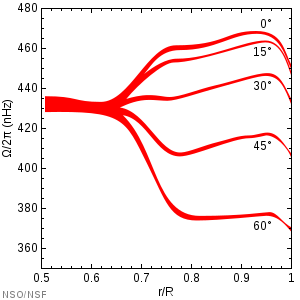Solar rotation
The sun rotates around its own axis in the same way that its planets orbit. As a gas ball, it does not rotate uniformly, but much faster at the equator than at the poles. In addition, different results are obtained depending on the measurement method , as it rotates faster under the surface . Conventionally, a sidereal rotation period of 25.38 days is specified, which corresponds to the average movement of sunspots at a heliographic latitude of 26 °. The synodic rotation period (in relation to the earth) averages about 27.28 days.
The axis of rotation of the sun is inclined by 7.25 ° to the ecliptic .
Basics
The reason that the sun and almost all objects in the universe rotate is often the compaction (compression) during their formation : In general, the components of the contracting dust and gas clouds do not move exactly towards the center of gravity , but rather have angular momentum . In the compaction, the distance is reduced to the center of gravity, so that due to the conservation of angular momentum , the rotational speed increases (see spins effect ).
Our central star has a much slower rotation than most other stars , which could be related to the special characteristics of our solar system (great distance between the planets).
Differential rotation

As a rotating gas ball, the sun does not rotate like a solid with a rigid rotation, but has - as was determined by sunspots around 1800 - a differential rotation : it rotates faster at the equator than near the poles .
This was suspected in the 18th century and examined in detail by R. C. Carrington and Gustav Spörer in 1863 . Result: the orbital period of sunspots in the equatorial region is about 25 days, of those at 45 ° latitude 27 days, near the pole over 31 days.
The exact dependence of the rotational speed on the heliographic latitude can be described by an empirical law with the constants , and , which was established by Carrington:
The three constants each also have the unit of a rotational speed.
Observing the Doppler shift of the spectral lines results in the following relationship:
From the observation of sunspots we get:
The difference in the constants indicates that the sun rotates faster inside than outside in the photosphere and therefore the sunspots (which are tied to the magnetic fields that are created inside) rotate faster than the photosphere gas.
In addition to the latitude and depth dependence of the rotation (between 24 and over 35 days), the rate of rotation also varies slightly in the cycle of sunspot activity .
A complete theory of solar rotation does not yet exist .
numbering
By RC Carrington rotation counting was introduced based on the sunspot observation that a mean synodical period sets of about 27.2753 days basis and on November 9, 1853 at 21:38 UTC began with the solar rotation no. 1st
On the basis of Julius Bartels ' investigations into geomagnetic activity, another rotation counting with a period of exactly 27 days was introduced, starting on February 8, 1832.
Effect on the solar magnetic field
Due to the rotation of the sun, the solar magnetic field , which is directed outwards by the solar wind , takes on the shape of a spiral , which rotates with an orbital period of about 25 days.
See also
Individual evidence
- ^ Wilcox Solar Observatory ( Stanford ): Carrington and Bartels Calendars
- ^ Hannu Koskinen: Physics of Space Storms: From the Solar Surface to the Earth . Springer Science & Business Media, 2011, ISBN 3-642-00319-2 , p. 9 ( limited preview in Google Book search).
- ↑ WSO: Carrington and Bartels Calendars (English)
- ↑ Carrington's solar rotation ( Memento of the original from July 4, 2008 in the Internet Archive ) Info: The archive link was inserted automatically and has not yet been checked. Please check the original and archive link according to the instructions and then remove this notice.
- ↑ Bartels, J. (1934): Twenty-Seven Day Recurrences in Terrestrial-Magnetic and Solar Activity, 1923-1933 , Terrestrial Magnetism and Atmospheric Electricity 39: 201-202a
literature
- Arnold Hanslmeier : Introduction to Astronomy and Astrophysics , 3rd edition 2014, ISBN 978-3-642-37699-3
- Joachim Gürtler and Johann Dorschner: The solar system . Barth, Leipzig - Berlin - Heidelberg 1993. ISBN 3-335-00281-4
Web links
- An animation of the outer solar rotation (English)









